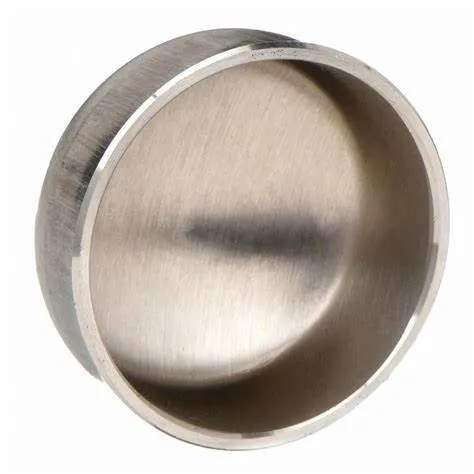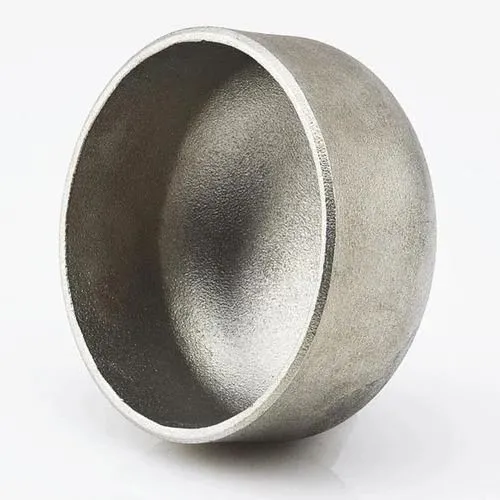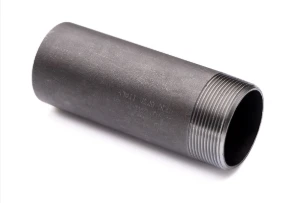Ang JIS B2311 usa ka Japanese Industrial Standard nga nagsakup sa butt-welding pipe fittings, lakip ang mga takup nga gigamit sa mga sistema sa tubo. Ang butt-welding caps nagsilbi nga katuyoan sa pagsira sa tumoy sa usa ka tubo, paghatag usa ka selyo aron malikayan ang pagtulo o kontaminasyon. Ania ang usa ka pasiuna sa JIS B2311 butt-welding caps:
- 1. JIS B2311 Standard:
- - Ang sumbanan sa JIS B2311 nagtino sa mga kinahanglanon alang sa disenyo, sukat, materyales, paghimo, ug pagsulay sa butt-welding fitting, lakip ang mga takup, sa mga sistema sa tubo.
- - Ang sumbanan nagsiguro nga ang mga takup nga gihimo sa pagsunod sa mga sumbanan sa JIS nakab-ot ang kalidad nga mga sumbanan ug nahiuyon sa ubang mga sangkap sa tubo.
- 2. Butt-Welding Cap:
- - Ang usa ka butt-welding cap, sumala sa JIS B2311, usa ka haom nga gidisenyo aron matabonan ug masilyohan ang tumoy sa usa ka tubo nga luwas, nga naghatag proteksyon ug pagpadayon sa integridad sa sistema sa tubo.
- - Ang mga takup gigamit sa mga sitwasyon diin ang tumoy sa tubo nanginahanglan pagsira, permanente man o temporaryo, aron malikayan ang pagtulo, kontaminasyon, o aron mahatagan ang pagkahuman sa sistema.
- 3. Materyal ug Pagtukod:
- - Butt-welding caps ubos sa JIS B2311 specifications anaa sa nagkalain-laing mga materyales sama sa carbon steel, stainless steel, ug alloy steel aron matubag ang lain-laing mga kinahanglanon sa aplikasyon.
- - Kini nga mga takup gihimo gamit ang standardized nga mga pamaagi sa pagtukod aron masiguro ang usa ka lig-on ug wala’y pagtulo nga koneksyon kung gi-welded hangtod sa katapusan sa usa ka tubo.
- 4. Aplikasyon ug Mga Benepisyo:
- - Ang butt-welding caps makakitag mga aplikasyon sa lain-laing mga industriya, lakip ang lana ug gas, kemikal nga mga proseso, water treatment plant, ug uban pa diin ang pipe endings kinahanglan nga takpan nga luwas.
- - Ang mga takup naghatag proteksyon sa mga tumoy sa tubo gikan sa mga elemento sa kalikopan, malikayan ang kontaminasyon, ug makatabang sa pagpadayon sa kalimpyo ug integridad sa sistema sa tubo.
- 5. Pag-instalar ug Welding:
- - Ang husto nga mga pamaagi sa pag-install, lakip ang husto nga pag-align, pag-andam sa katapusan sa tubo, ug mga teknik sa welding, hinungdanon kung mag-instalar sa mga takup sa butt-welding aron masiguro ang usa ka hugot ug dili mabuak nga selyo.
- - Ang welding usa ka sagad nga pamaagi sa paglakip sa mga takup sa mga tubo, nga naghatag usa ka luwas ug permanente nga pagsira nga makasugakod sa presyur, pagbag-o sa temperatura, ug pag-agos sa likido sa sulod sa sistema.
- Sa katingbanan, ang JIS B2311 butt-welding caps hinungdanon nga mga sangkap nga gigamit sa mga sistema sa tubo aron ma-seal ug mapanalipdan ang katapusan sa mga tubo nga luwas. Kini nga mga takup nahiuyon sa standardized nga mga kinahanglanon aron masiguro ang kalidad, kasaligan, ug pagkaangay sa sulod sa mga aplikasyon sa industriya kung diin kinahanglan ang pagsira ug proteksyon sa tubo.
What Is a Butt Welding Cap and How Is It Used in Industrial Piping?
In industrial piping systems, end-of-line sealing and branch closures require robust solutions. A butt welding cap serves as a critical component for terminating pipes securely. By providing a seamless, welded closure, this fitting maintains system integrity, prevents leaks, and supports compliance with industry standards.
What Is a Butt Welding Cap?
A butt welding cap—also called a pipe end cap or buttweld end cap—is a round fitting designed to close off the end of a pipe. It’s manufactured to match the pipe’s outer diameter and schedule, with either a hemispherical or flat face. To install, both the pipe end and cap are beveled to form a V‑groove, enabling full‑penetration, fusion welds. Common materials include carbon steel, stainless steel, nickel alloys, and other engineered grades, chosen to satisfy pressure, temperature, and corrosion‑resistance requirements.
How Is Butt Welding Cap Used in Industrial Piping?
Butt welding caps find application across oil & gas, petrochemical, power generation, water treatment, and general process industries for both permanent and temporary closures. During hydrostatic testing, technicians install caps to seal off sections of piping while monitoring for leaks. In new construction or retrofit projects, caps terminate branch lines, future tie‑in spools, or dead‑end mains until system expansion. Welders prepare each joint by cleaning and beveling surfaces, aligning the cap precisely, and executing a root pass followed by filler passes per the qualified Welding Procedure Specification (WPS). Post‑weld heat treatment and non‑destructive examination (NDE)—such as radiography or ultrasonic testing—verify weld integrity and compliance with ASME B16.9 and related standards. Additionally, temporary caps enable safe isolation during maintenance, allowing for segment testing and dewatering under regulatory protocols.
Benefits and Best Practices
Butt welding caps offer a smooth‑bore transition that minimizes flow disruption and stress concentration. Their full‑penetration welds deliver exceptional structural strength and leak resistance. To optimize performance, engineers should:
Select caps with matching material grades and wall thicknesses
Adhere to proper bevel angles and joint fit‑up tolerances
Follow qualified WPS protocols rigorously
Consider cladding or protective coatings in corrosive environments to extend service life
Regular inspection and thorough documentation ensure long‑term reliability and safe operation under demanding conditions.
Butt welding caps are indispensable components for achieving durable, leak‑proof pipe terminations in a wide range of industrial applications.
Butt Welding Cap FAQs
What is a butt welding cap?
|
What materials are commonly used?
|
What standards govern butt welding caps?
|
How are butt welding caps installed?
|
Where are butt welding caps typically used?
|
What are the advantages of threaded caps?
|
















